
In the realities of U.S. law, one distinction that often confuses many is the difference between bond and bail. Bail upholds the presumption of innocence, but not everyone can access it, so it’s important to know your options and how bonds can help. This article delves deep into the world of bond vs bail, shedding light on their key differences and their roles in the legal process.
While both serve as mechanisms for pre-trial release, they operate in different ways. Let’s discuss the bond vs bail meaning, its distinctions, and implications.

Navigating the difference in bail and bond:
Bail:
Bond:
In essence, when you’re released on bond vs bail, it’s about who’s putting up the money and the strings attached.
So, what is bond vs bail? Bail is your money on the line, while bond involves a third-party guarantee.
To deal with the question “Is bail and bond the same thing?”, let’s delve into the issue of what does out on bail mean.
The definition of bail is a set amount of money that acts as insurance between the court and the person in jail. While defendants have the option to pay this amount in cash, many find the set amount unaffordable.

On average, bail for crimes hovers around $10,000. But, when the bail amount rises above the midpoint, the defendants who can secure release on bail drop. Over 60% of defendants remain in detention before trial due to their inability to pay bail.
The bail out of jail meaning revolves around a mechanism that ensures defendants return to court for their trial after their release from custody. It stands as a form of assurance, ensuring that while the accused can proceed with their daily life, they remain obligated to meet their legal duties.
When comparing bail versus bond, it’s important to note one similarity. By posting bail, the accused undertakes to appear in court for all scheduled proceedings.
Under bond and bail policy guidelines, if a defendant misses a court date or doesn’t follow court mandates, the court can seize the bail amount. This policy deters defendants from neglecting court rulings and schedules.

When someone’s suspected of a crime, law enforcement springs into action, leading to an arrest. But what happens next in the bond and bail process?
Post-arrest, our individual lands in custody, getting the full booking treatment: personal details logged, fingerprints taken, and a snapshot of the alleged misdeed.
Then comes the arraignment, a courtroom debut where the stakes are high. Here, they’re clued in on the charges, reminded of their Miranda rights, and introduced to their right to legal counsel. Can’t afford a lawyer? No worries, the court’s got their back with a public defender. Next, they’ll make their plea: guilty, not guilty, or no contest.
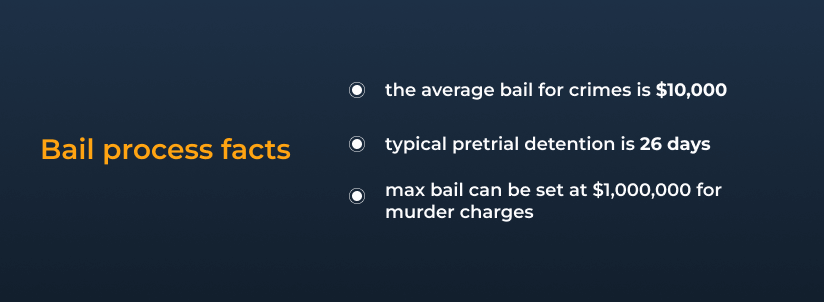
The spotlight then shifts to the judge who makes the decision: to bail or not to bail? Weighing various factors, the judge sets the bail tone. In the U.S., the typical pretrial detention stretches on for 26 days. If our individual can foot the bail bill or post a bond, they’re back to the grind, free to live their life while the trial awaits.
Factors influencing the bail amount include:
So you need to realize the weight of your charge and criminal line. For example, the bail for a potential involuntary manslaughter sentence is $25,000, while for premeditated murder it is on average $100,000. In turn, for the first offense related to drunk driving, the bail amount starts at $500. But for repeat felony OVI, the penalty is already $10,000.
In some cases, other factors outlined in the Bail Reform Act, 18 USC §3142 come into play. It’s beneficial to consult a lawyer who can assess the risks for you.
Defendants can pay bail in cash or use assets as collateral. If they can’t afford it, they might seek the services of a bail bondsman, who will post bail on their behalf for a fee.
Check out these payment pathways:
The choice between options hinges on finances, so consider it carefully.
Keep reading to figure out the types, bond vs bail benefits, and drawbacks that may arise.
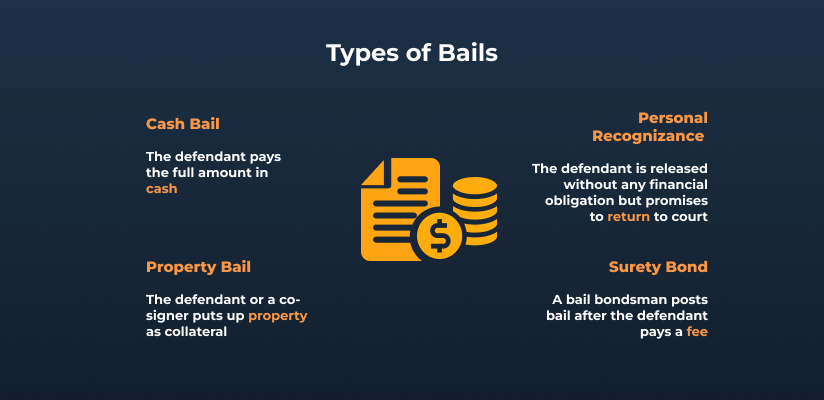
Here’s a breakdown of bail options that a defendant may encounter:
While cash bail involves a direct payment, property bonds use assets as a guarantee. Personal recognizance relies on the defendant’s promise and compensation for emotional distress. Surety bonds involve a third-party bail bondsman. The type of bail granted often depends on the defendant’s financial situation, the nature of the crime, and their record.
Now let’s weigh the pros and cons of bail.
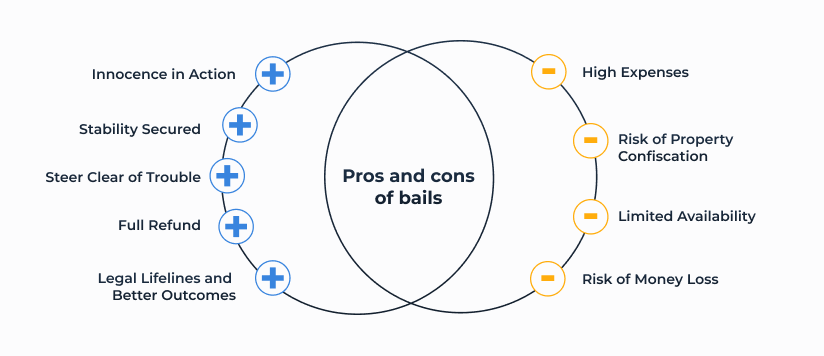
Dive into the bail advantage guide:
So bail is a great decision when it comes to going about your daily life while awaiting trial. It also reduces overcrowding in jails.
But, bail has several drawbacks:
High bail amounts can be financially draining. Bail, especially for serious charges, can put a hefty financial strain on the defendant or their family.
There’s also the risk of losing the bond vs bail money if the defendant doesn’t follow court mandates.

Check out our article “How Many Female Lawyers in the US? Statistics Overview“
You’ve learned what is bail and how it works. But what’s the real scoop behind the bail vs bond difference? Let’s demystify the nuances of bond legal definition and set the record straight!
A bond is an agreement where a third party, often a bail bondsman, commits to covering the bail amount should the defendant not show up in court.
The defendant pays a fee (10-20% of the bail amount) to the bondsman, who then posts bail. If the defendant appears in court, the bondsman gets back the bail amount but keeps the fee. For example, if bail is 250,000, how much do I pay? You’d pay 25,000, and even after closing the case, you won’t get this amount back.

Not sure what does it mean to be released on bond? Here’s a quick guide:
If the defendant does not have enough money to post bail, a bondsman comes to the rescue. Their mission? Offering a secured bond, ensuring the defendant’s freedom until trial.
By posting the bond, the agency commits to ensuring the defendant’s court appearance. Why? The difference in bond versus bail payment is large. If the defendant skips court or violates a restraining order, the agency could foot the entire bail bill.
But if the defendant plays by the rules? The bondsman completes their job, but they keep the fee. Behind the scenes, bondsmen also tackle the legalities, making sure the bond sails in court. With their expertise in the legal maze and the nuances of what is a personal bond, these agencies guide defendants, making bail accessible to many who can’t pay upfront.
These are the bond types a defendant might need to post to get released from jail:
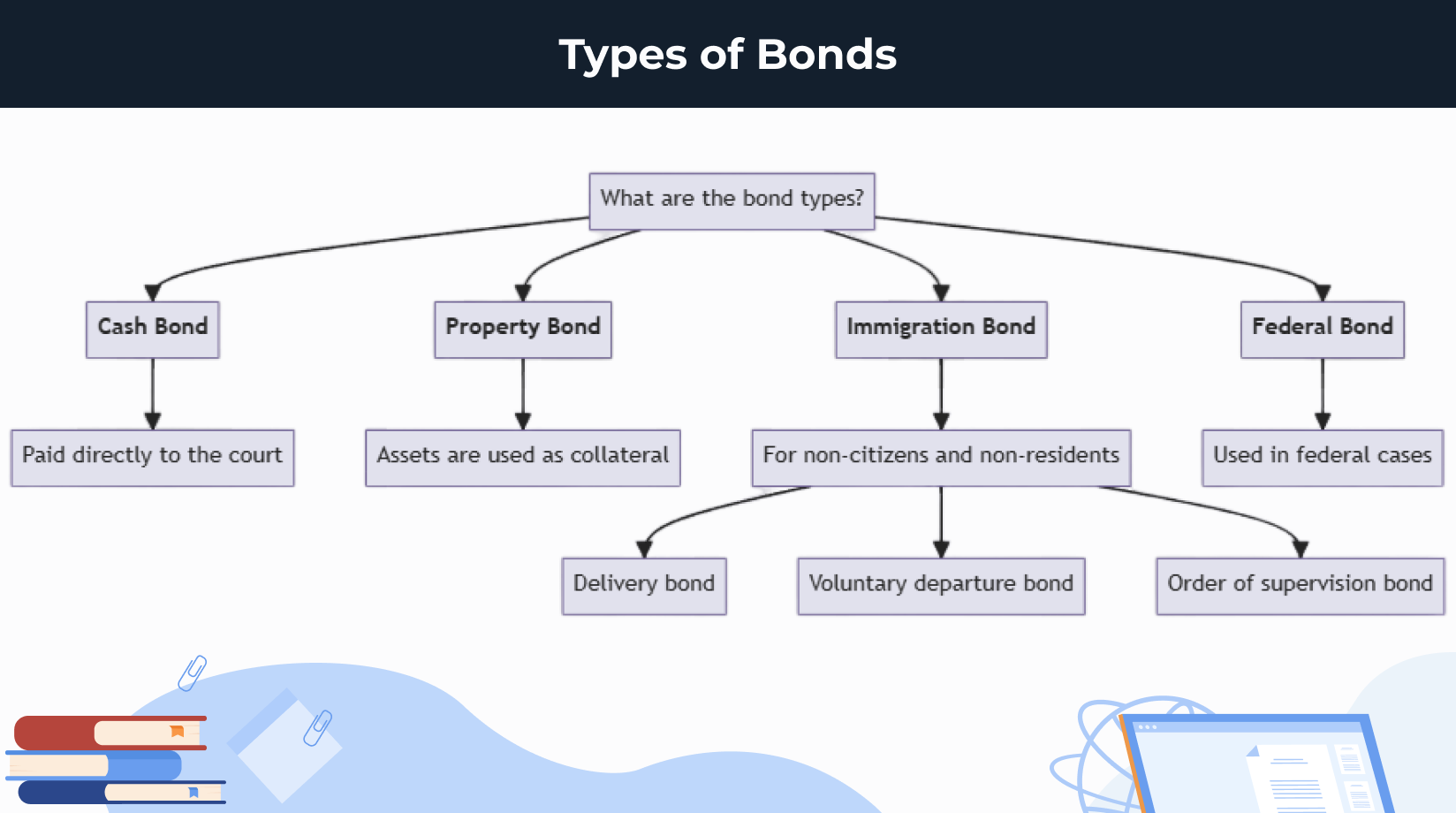
Depending on the immigration bond type:
Keep reading to discover the advantages and disadvantages of bonds as we delve into bonded out meaning in this section.
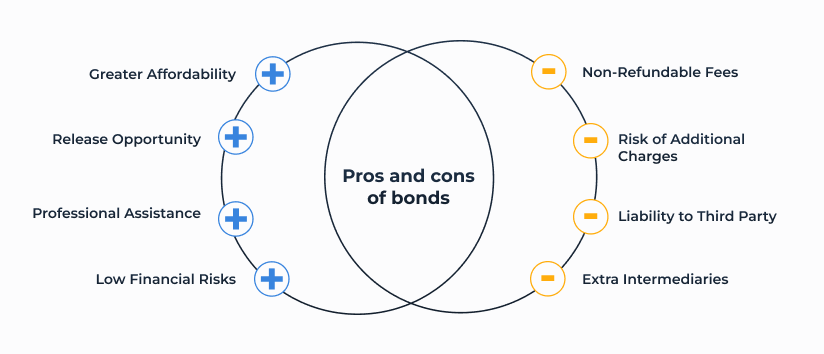
Here are the key features of a bond:
So, a surety bond will come in handy when dealing with the nuance of money and legal paperwork.
But it’s also worth taking into account possible drawbacks:
While a secured bond means someone vouches for you, it’s still your responsibility to appear in court, so consider the disadvantages first.
Deciding between posting bond vs bail? Here are some factors to consider:
Bond vs Bail Costs and Returns
Who’s Got Your Back?
A bondsman takes on risks and responsibilities. They’re your safety net when you’re out on bond vs bail.
Legalities and Loopholes
Assets and Ties
The Long Game
Weigh the now vs. the later. What feels cheap now might cost you more in the end.
When in doubt, chat with an attorney or contact us for а legal advice. We’ll help you navigate the bond vs bail maze.
Yes, if the defendant complies with all court mandates, bail money returns, minus 10% fees in the case of bonds.
The duration varies, but a defendant can be out on bond for 90-120 days on average.
When bail is set for a person arrested in Florida, the amount is not refundable. Also, a defendant handles the rest of the bail provided by the bond agent if they forfeit the bail.
In Texas, bail is the amount set by the court, while a bond is an agreement to pay that amount, either by the defendant or a third party. Bail for misdemeanors in state prison usually ranges from $500 to $1,500.
In Michigan, if the defendant fails to appear in court, the bail bondsman pays 100% of the bail amount. You also cannot leave the state if you are on bail.










